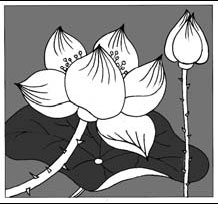Paying homage to the lotus
By Hong Liang (China Daily)Updated: 2007-07-31 07:12
The lotus flower is special to the Chinese. Thanks to Song Dynasty mandarin scholar, Zhou Dunyi, this particular species of the water lily has been revered by generations of Chinese as a symbol of the perfect gentleman.
 In Zhou's celebrated essay Ode on the Lotus, the flower is likened to a
virtuous person steadfastly holding on to his lofty principles in a world mired
in decadence and mediocrity. Here's my clumsy attempt to translate into English
the spirit of the key verses in his essay, which I, like millions of fellow
Chinese, have learned by heart.
In Zhou's celebrated essay Ode on the Lotus, the flower is likened to a
virtuous person steadfastly holding on to his lofty principles in a world mired
in decadence and mediocrity. Here's my clumsy attempt to translate into English
the spirit of the key verses in his essay, which I, like millions of fellow
Chinese, have learned by heart.
The lotus flower, so pure in form, soars untainted from the muddy bed of the marshland from which it sprouted. Wavering in the gentle breeze, it stands tall on its straight and brittle stem above the murky water graced by its reflection.
There is nothing murky about such powerful imagery that have become particularly relevant at a time when traditional values of the scholar and the gentleman have largely been forgotten in the mad pursuit of economic gains. So, perhaps, we should pay homage to the lotus this summer while we can still remember Zhou's writing.
A Chinese poet once said that no words could do justice to the sheer beauty of the lotus flower in full bloom. But do not despair. They are not some rare species that can only be sighted in the deepest recesses of the tropical rain forest or the Siberian plain. In fact, the lotus can be found in abundance in their native habitat in South China.
To many connoisseurs, Baoying, a small town in Jiangsu Province, about four hours drive from Shanghai, is the undisputed lotus capital of the region, if not the entire country. Every summer, the unspoiled marshland near the town is blanketed by many thousands of darkish green lotus leaves, some of them as large as the top of a standard side table. Embroidered on that vast green expense is a multitude of colorful lotus flowers of all sizes, radiating a delicate fragrance that fills the air and brings a welcome relief to the stifling humidity and heat.
A throng of dragonflies, in red, blue and black, dashing from one flower to another, adds a splash of gaiety to the tranquil scene.
On some days the marshland is teaming with women, wearing broad-brim hats to shield their faces from the hazy glare of the summer sun, humming native folk songs on sampans, while they gather lotus seeds that are usually crushed to make the popular sweet filling of a wide variety of Chinese buns and cakes.
The town hosts a Lotusfest every summer when restaurants
and eateries try to outdo each other with dishes that feature the edible parts
of a lotus plant, mainly the seeds and roots. 
The crunchy young lotus roots, harvested in July, are a favorite of the locals. Usually stir-fried with pork, the thinly sliced lotus roots are said to lend an unique and delicate flavor to the dish. Lotus seeds are also served whole in a variety of syrupy soups as desert. To aficionados, few summer delicacies can be as agreeable to the stomach as well as the senses as steam rice wrapped in lotus leaves.
At the Lotusfest in Baoying, the standard drink is, of course, lotus root juice in cans or bottles. It is an acquired taste. If you do not like it, tea is an acceptable alternative. Just refrain from ordering coke or other soft drinks in a lotus feast. The strong artificial flavors of these beverages can overwhelm the subtle taste of the laboriously prepared food.
You do not have to miss the lotus season even if you find the trip to Baoying too troublesome. Lotus flowers can be found in the ponds of many neighborhood parks. A friend gets great satisfaction watching his lotus flower floating on water in a large glass bowl in his Shanghai apartment.
It is all in the mind.
E-mail: jamesleung@chinadaily.com.cn
(China Daily 07/31/2007 page10)
|
|
|
|